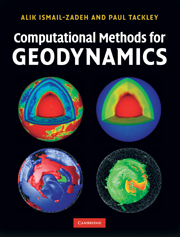Book contents
- Frontmatter
- Contents
- Foreword by Gerald Schubert
- Preface
- Acknowledgements
- 1 Basic concepts of computational geodynamics
- 2 Finite difference method
- 3 Finite volume method
- 4 Finite element method
- 5 Spectral methods
- 6 Numerical methods for solving linear algebraic equations
- 7 Numerical methods for solving ordinary and partial differential equations
- 8 Data assimilation methods
- 9 Parallel computing
- 10 Modelling of geodynamic problems
- Appendix A Definitions and relations from vector and matrix algebra
- Appendix B Spherical coordinates
- Appendix C Freely available geodynamic modelling codes
- References
- Author index
- Subject index
- Plates section
10 - Modelling of geodynamic problems
Published online by Cambridge University Press: 05 June 2012
- Frontmatter
- Contents
- Foreword by Gerald Schubert
- Preface
- Acknowledgements
- 1 Basic concepts of computational geodynamics
- 2 Finite difference method
- 3 Finite volume method
- 4 Finite element method
- 5 Spectral methods
- 6 Numerical methods for solving linear algebraic equations
- 7 Numerical methods for solving ordinary and partial differential equations
- 8 Data assimilation methods
- 9 Parallel computing
- 10 Modelling of geodynamic problems
- Appendix A Definitions and relations from vector and matrix algebra
- Appendix B Spherical coordinates
- Appendix C Freely available geodynamic modelling codes
- References
- Author index
- Subject index
- Plates section
Summary
Introduction and overview
In this chapter we review the numerical methods that have been, or are being, used for various geodynamic problems, pointing the reader to relevant sections in this book, giving additional implementation information, and referring to detailed information elsewhere. The applications are mostly related to deformation of the solid Earth (mantle and crust), with a short discussion in the last section on methods for the liquid outer core, where the geodynamo is generated. The intent here is to focus on the numerical methods not the scientific results, for which the reader is referred to comprehensive discussions elsewhere (Schubert et al., 2001; and volumes 6-8 of Schubert, 2007). This is also not intended to be an exhaustive survey, but rather to highlight common modelling problems involving technical aspects that are not covered in earlier chapters.
Historically the mantle convection research community has been somewhat separate from the crust/lithosphere dynamics modelling community. This is partly a result of the different dynamical regimes, with mantle convection occurring by viscous creep over long time scales, while crust/lithosphere deformation involves more complex rheology (visco-elastoplastic), widespread localisation of deformation, shorter time scales, and the possibility that a free surface and surface processes may be important. It is also because different sets of observations are being explained, with mantle dynamicists interested in the longterm, large-scale and often deep, while crust/lithosphere dynamicists' research is closely tied to geological observations and shallow structure.
Information
- Type
- Chapter
- Information
- Computational Methods for Geodynamics , pp. 216 - 249Publisher: Cambridge University PressPrint publication year: 2010
